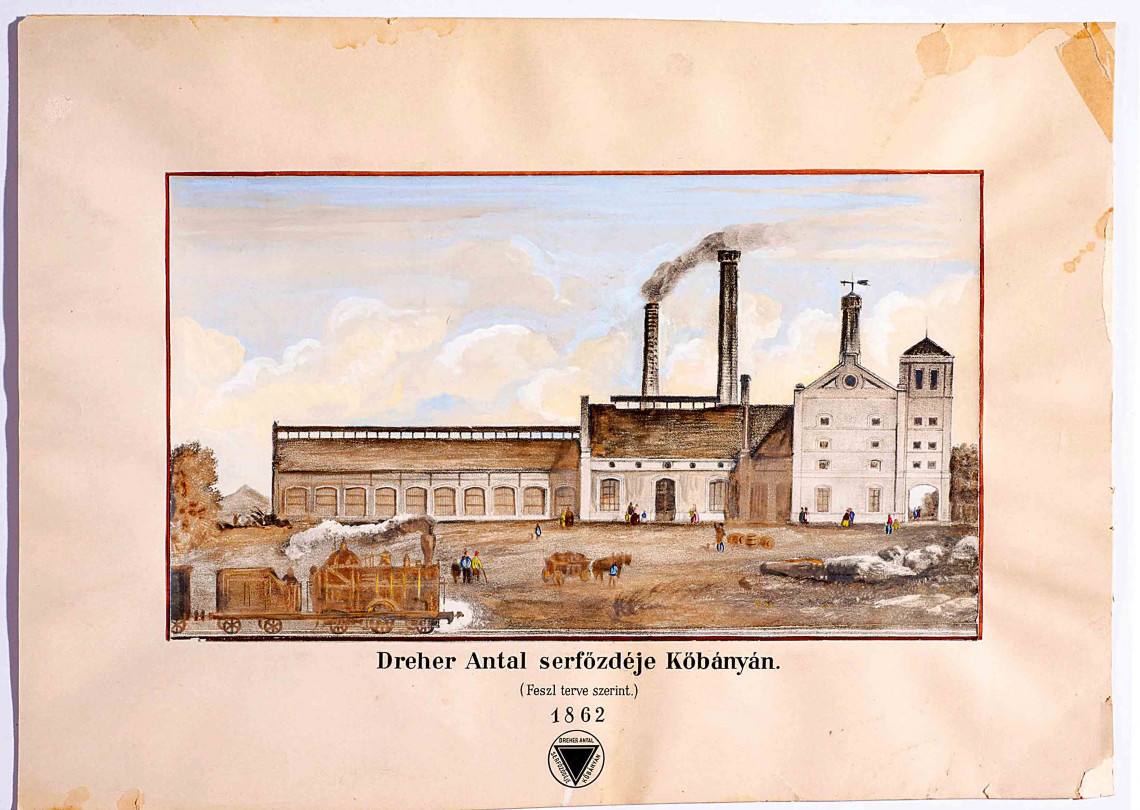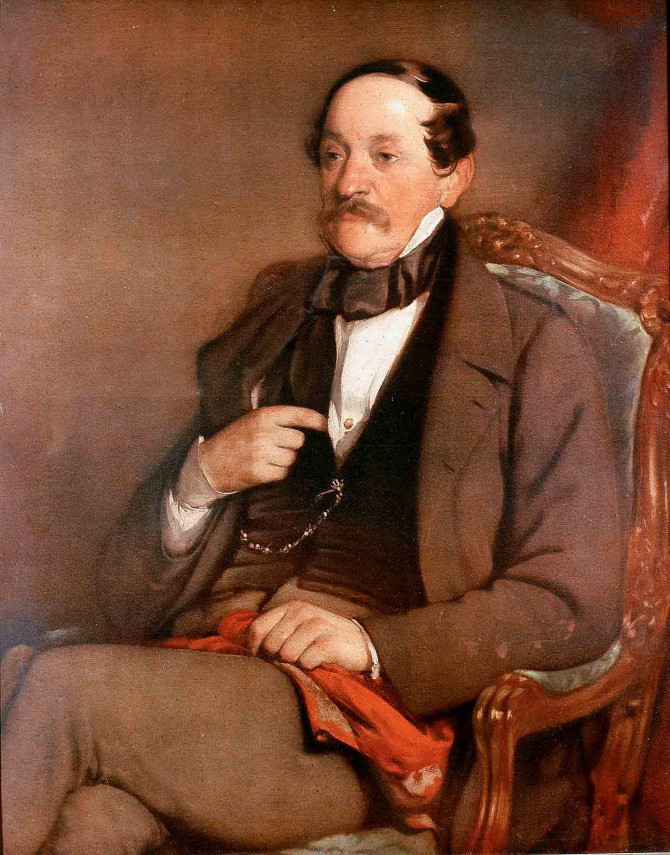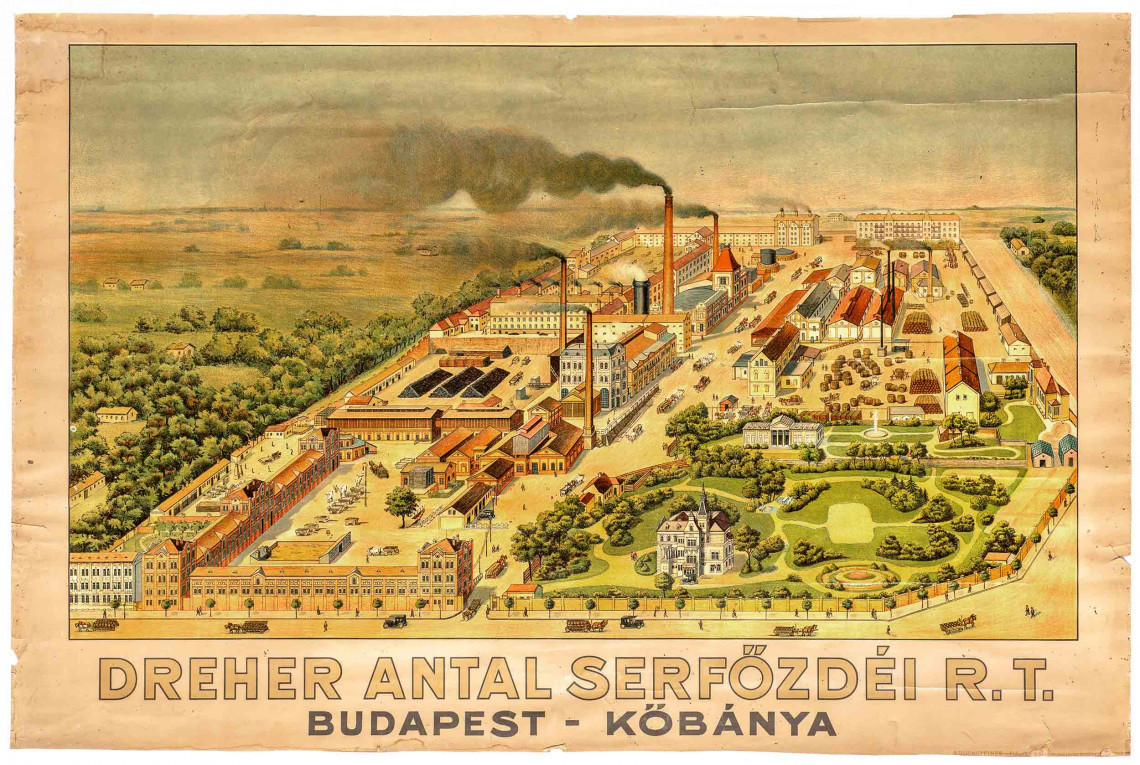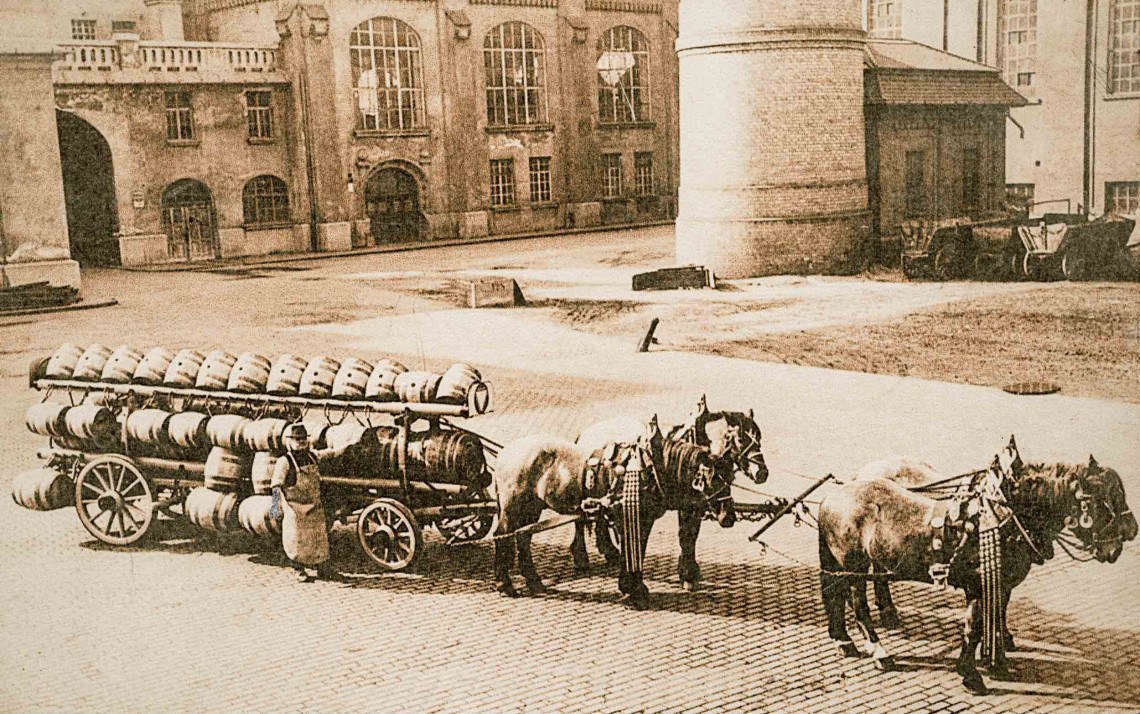In 1841, the Austrian brewer Anton (Antal) Dreher crafted the first modern lager beer under the name Bécsi Ászok (Vienna Aces). The lager would reign supreme in the Habsburg Empire for barely a year before being eclipsed by a new competitor – Czech pilsner – which entered the market in 1842 and continues to dominate large-scale beer production even today. The latter’s appearance would also be partially responsible for forcing Dreher out of Austrian territory as he sought out a new base and market for his beer empire where regional advantages and demand could strengthen his product. Kőbánya, with its proximity to the Great Hungarian Plain, its high-quality grain, the Pest-Buda railway network, and last but not least the extensive Kőbánya cellar system, seemed to offer the most advantageous location: this was where the center of the modern European and Hungarian brewing industry emerged.

The founder
Franz Anton Dreher Jr. (1736-1820), founder of the Dreher dynasty and its centuries-old tradition, was born in Pfullendorf in what is now the German state of Baden-Württemburg. Like many other Swabians, he made the journey down the Danube to arrive at the burgeoning Austrian capital of Vienna around 1760. He first worked as a baker’s apprentice, then as a beer waiter and a bartender. In 1773, he leased a small brewery in Oberlanzendorf, south of Vienna, but its capacity of 40 liters soon proved inadequate and in 1782 he took over another brewery in Vienna’s Leopoldstadt district. The capital that Dreher had managed to accumulate was supplemented by the dowry from his wealthy wife, Maria Anna Huber, the daughter of a rich tax collector from Achau, south of Vienna.
The once-penniless beer waiter had become a company founder. In 1796, Franz Anton purchased the brewery and associated farmstead in Klein-Schwechat, near Vienna, which had been in operation since 1632. Over time, he became a respected Viennese brewmaster and was elected head of the Viennese brewers’ guild in 1806. Following the death of his first wife, Anna, in 1803, he married Katherine Widter (1786–1864), who also came from a brewer’s family. The couple’s daughter Clara (Klára) (1806–1875), the eldest of their four children, married Franz (Ferenc) Aich Sr. (1803–1875), who would later manage the Dreher factory in Kőbánya.
The period of the Napoleonic Wars, however, found Franz Anton in straitened financial circumstances at which point he leased the Schwechat brewery to his nephew, Johann Nepomuk Anton Dreher (1779–1819).
The “beer king”
Franz Anton’s heir, Anton Eugen Dreher (1810–1863), also known as Anton Dreher Sr., was only ten years old when his father died in 1820. His cousin – Johann Nepomuk – had died in 1819, thus leaving Anton Eugen’s widowed mother, Katherine, to take over management of the brewing business and its accumulated debts. In order to retain both the property and the business, Katherine was forced to remarry, becoming the wife of Franz Hartl, an official at the royal Laxenburg estate, south of Vienna.

After completing his schooling, Anton Eugen began learning the art of brewing beer – first at home in Austria and then later in Munich. Having befriended Gabriel Sedlmayr, the young owner of Munich’s Spaten brewery, the two young men set off to tour the main centers of the German and English brewing industry. Upon returning home in 1836, Anton Eugen assumed control over his inheritance – the 200 year old Schwechat brewery – and set about expanding it. In pursuit of this, he introduced Bavarian-style bottom fermentation technology and in the winter of 1841 developed a new type of beer made from Viennese malt.
Anton Eugen soon conquered the world with his new lager, earning the honorary title “the Beer King” within the industry. He subsequently made further improvements to the Schwechat brewery, built a mansion in Vienna, and opened a beer hall and a guesthouse. As a prominent Viennese businessman, he also involved himself in politics. He made frequent trips to Pest-Buda, including stops in Kőbánya, midway between the two imperial capitals, where he was impressed by the local breweries, their rock cellars, and the quality of the beer produced there. Not wasting time, he quickly bought land and an attached cellar in 1859 with the intention of building his own brewery in the area.
Shortly after making his purchase, the neighboring Kőbánya Serház brewery was put up for sale. The brewery’s owner, Jakab Perlmutter, had fallen into debt in expanding his operations a few years earlier and thus proposed selling his enterprise to “the Beer King.” Upon signing the contract on October 17, 1862, Anton Eugen set about establishing a model lager brewery. He had barely taken his first steps, however, when he suddenly passed away upon returning from a theatrical performance in late 1863.

The Innovator
With his father’s death, Carl Anton Dreher (1849–1921), also known as Anton Dreher Jr., became the representative of the third generation of this brewing family, inheriting factories in Schwechat, Michelob (in present-day Czezchia), and Kőbánya. Like his father, Carl Anton studied and learned his trade in Europe. While he was away studying, his father’s loyal colleagues assumed management over the Kőbánya brewery and continued to expand it. Ágoston Deiglmayer and Ferenc Aich – the latter being Carl Anton’s uncle and guardian – also came from brewing families. By the time Carl Anton assumed direct control, the Kőbánya factory was already producing 100,000 hectoliters of beer annually.
“The Beer King’s” ambitious son managed the Kőbánya complex for 35 years and developed it into the largest brewery in the country. By taking advantage of opportunities that arose, seeking out innovative solutions to problems, and collaborating with others, Carl Anton expanded his brewery’s operations to an industrial scale. He drilled wells, built a new technologically innovative pneumatic malting plant and brewery, reinforced the existing cellars, and had ventilation shafts opened and installed. He even used ice from the Danube in the maturation process and for storing the finished product. He also strengthened his family’s connections to other brewing concerns through his marriage to Katharina Meichl (1850-1937) of the Austrian Meichl brewing family.
It was under Carl Anton’s leadership that the Dreher brand was established. Several successful sub-brands were also launched at this time, including Bak, Király, Korona, Márciusi, Szent János, and the Tavaszi (Spring), Őszi (Autumn), and Téli (Winter) beers. The numerous certificates of merit and gold medals won at various trade fairs and world exhibitions attest to the success of these products. Among others, it won gold medals at the Paris World Expositions of 1867, 1878 and 1900. Dreher had now become a well-established and recognized brewery within the Austro-Hungarian monarchy and throughout Central Europe.
Beer was first bottled in Hungary at Kőbánya in the 1870s and thence exported to many countries around the world. In 1868, a new Dreher factory was established in Trieste which was the first to incorporate an artificial refrigeration process devised by the German engineer Carl von Linde. In addition to production innovations, Carl Anton also provided credit to those restauranteurs and publicans who regularly purchased his product. In 1897, he was honoured for his efforts by Emperor Franz Joseph, who made him a Knight Commander of the Imperial Austrian Order.

Carl Anton was a well-known polo player who kept his own stud farm and his son Jenő inherited his passion for horses. Around the turn of the century, he undertook the process of converting his enterprises into joint stock companies. In 1913 he consolidated his Vienna breweries into a single corporation. By the time of his death in 1921, however, his son, Jenő Dreher, had inherited a beer empire that was falling apart due to the various wars and economic crises.
The Unifier
While Jenő Dreher (1879–1949) acted as chairman of the company’s board of directors, management of the Kőbánya brewery itself was run by his relatives, the Aich family, for several generations. An exceptionally talented leader and versatile personality, it was the German-Austrian Jenő who chose Hungary as his permanent home. His family responsibilities included managing the Hungarian estates in Martonvásár, Vál, and Tordas, supervising the brewery, and overseeing horse breeding and stable-related work. Like his father, Jenő was a keen horseman.
Through his Swiss-born wife Berta Lujza Haggenmacher (1878–1970), Jenő married into a wealthy family with interests in domestic grain, malt, and beer industries. The Hungarian beer industry faced its biggest crisis after World War I, with declining production exacerbated by the global economic crisis. Jenő, having assessed the possibilities, embarked upon new ventures while retaining malt production and reorganizing the beer industry. He sold his factories, retaining only Kőbánya, where he operated a brewery whose building now houses the First Hungarian Brewery Co. (Első Magyar Részvény Serfőződe Rt.). In 1923, he consolidated the Kőbánya breweries into a single concern, creating the Dreher-Haggenmacher First Hungarian Brewery Co. (Dreher-Haggenmacher Első Magyar Részvény Serfőződe Rt.).
Expanding his businesses with sustainability in mind, Jenő established a biscuit and chocolate factory (Dreher-Maul), a cognac and liqueur factor (Dreher-Fockink), a textile factory, a dairy and pharmaceutical company, and a baby food factory. Having restored the Dreher brand name, Jenő also invested in the hotel sector, acquiring the Hungária Grand Hotel, the Ritz (later the Dunapalota), and the National Hotel. In 1928, he purchased the Király Brewery Co. (Király Sörfőzde Rt.) in Nagykanizsa in order to gain a foothold in the Trandanubian beer market. The Dreher concern now controlled 70% of the domestic market. By the end of the 1930s, Dreher had also acquired the brewery in Nagyvárad (Oradea), now in Romania.
Having survived World War II, Jenő Dreher tried to adapt to the new world order. However, his hopes were quickly dashed by nationalization. Unlike many other board members, the elderly company director did not flee, choosing to remain in his homeland, where he died in 1949. His wife Berta and their two daughters, Mária Lujza and Anna Mária, left the country and ceased any further involvement in the beer industry. The members of this distinguished family are laid to rest in the Dreher crypts in Martonvásár and Schwechat, but the Dreher tradition and its centuries-old heritage live on and continue to flourish to this day.
(translated by Andrea Thürmer and John Puckett)
